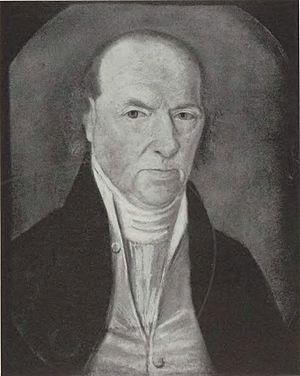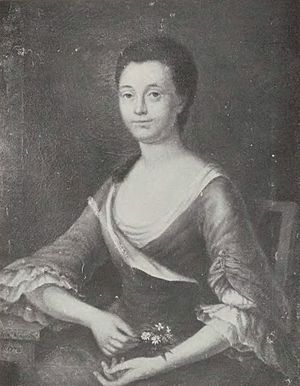John Blair Jr. facts for kids
Quick facts for kids
John Blair Jr.
|
|
|---|---|
 |
|
| Associate Justice of the Supreme Court of the United States | |
| In office February 2, 1790 – October 25, 1795 |
|
| Nominated by | George Washington |
| Preceded by | Seat established |
| Succeeded by | Samuel Chase |
| Personal details | |
| Born | April 17, 1732 Williamsburg, Virginia, British America |
| Died | August 31, 1800 (aged 68) Williamsburg, Virginia, U.S. |
| Political party | Federalist |
| Parent |
|
| Education | College of William & Mary (BA) Middle Temple |
| Signature | |
John Blair Jr. (April 17, 1732 – August 31, 1800) was an American politician, Founding Father, and jurist, who signed the United States Constitution.
Blair was one of the best-trained jurists of his day. A famous legal scholar, he avoided the tumult of state politics, preferring to work behind the scenes. He was devoted to the idea of a permanent union of the newly independent states, and loyally supported fellow Virginians James Madison and George Washington at the Constitutional Convention. As a judge on the Virginia court of appeals and on the U.S. Supreme Court he influenced the interpretation of the Constitution in a number of important decisions. Contemporaries praised Blair for such personal strengths as gentleness and benevolence and for his ability to penetrate immediately to the heart of a legal question.
Early life
John Blair Jr. was born in Williamsburg, Colony of Virginia, in 1732, to Mary (Monro) and John Blair. He was a member of a prominent Virginia family. His father served on the Virginia Governor's council and (on four occasions) an acting royal governor. His great-uncle, James Blair, founder and first president of the College of William & Mary.
Blair attended William & Mary, receiving a bachelor of arts in 1754. In 1755, he went to London to study law at the Middle Temple.
Career
Returning home to practice law, he was quickly thrust into public life, beginning his public career shortly after the close of the French and Indian War with his election to the seat reserved for the College of William and Mary in the House of Burgesses (1766–70). He went on to become clerk of the Governor's Council, the upper house of the colonial legislature (1770–1775).
Blair originally joined the moderate wing of the Patriot cause. He opposed Patrick Henry's extremist resolutions in protest of the Stamp Act, but the dissolution of the House of Burgesses by Parliament profoundly altered his views. In response to a series of taxes on the colonies passed by Parliament, Blair joined George Washington and others in 1770 and again in 1774 to draft nonimportation agreements which pledged their supporters to cease importing British goods until the taxes were repealed. In 1775, he reacted to the British Parliament's passage of the Intolerable Acts by joining those calling for a Continental Congress and pledging support for the people of Boston who were suffering economic hardship because of Parliament's actions.
When the American Revolution began, Blair became deeply involved in the government of his state. He served as a member of the convention that drew up Virginia's constitution (1776) and held a number of important committee positions, including a seat on the Committee of 28 that framed the Virginia Declaration of Rights and plan of government. He served on the Privy Council, Governor Patrick Henry's major advisory group (1776–1778). The legislature elected him to a judgeship in the general court in 1778 and soon to the post of chief justice. He was also elected to Virginia's high court of chancery (1780). The judicial appointments automatically made Blair a member of Virginia's first court of appeals. On the Virginia Court of Appeals, Blair participated in The Commonwealth of Virginia v. Caton et al. (1782), which set the precedent that courts can deem legislative acts unconstitutional. The decision was a precursor to the United States Supreme Court in decision Marbury v. Madison.
In 1786, the legislature, recognizing Blair's prestige as a jurist, appointed him Thomas Jefferson's successor on a committee revising the laws of Virginia. The following year, he was appointed as a delegate to the Constitutional Convention.
On September 24, 1789, President George Washington nominated Blair for one of the five associate justice positions on the newly established U.S. Supreme Court. He was confirmed by the United States Senate two days later. Blair served on the Supreme Court from February 2, 1790 until October 25, 1795. The court's caseload during Blair's tenure was light, with only 13 cases decided over six years. However, Blair participated in the court's landmark case of Chisholm v. Georgia, which is considered the first United States Supreme Court case of significance and impact.
Personal life
He was married to Jean Balfour Blair.
He died in Williamsburg on August 31, 1800. He was buried at the Bruton Parish Churchyard in Williamsburg.
Blair was a Freemason. He was named Grand Master of Freemasons in Virginia under the newly organized Grand Lodge of Virginia in 1778.
Blair Street in Madison, Wisconsin is named in his honor.


